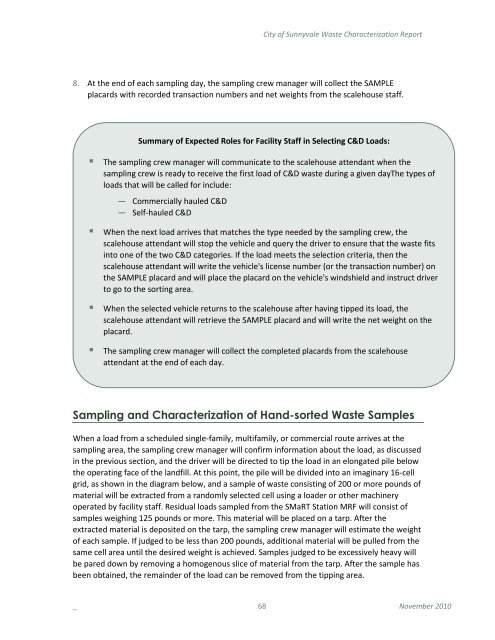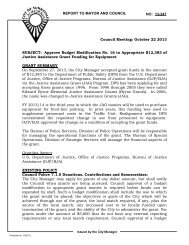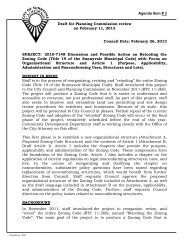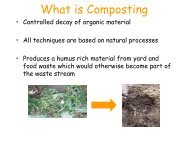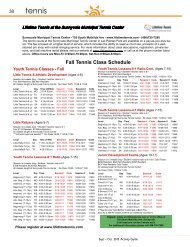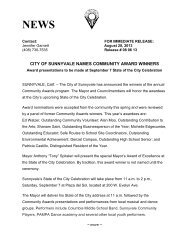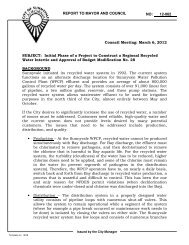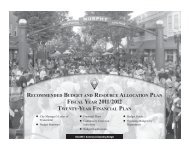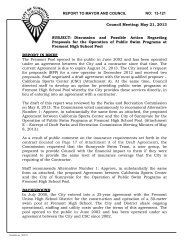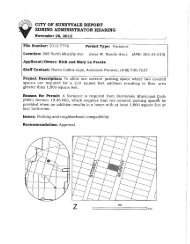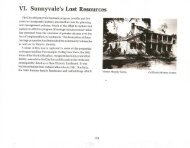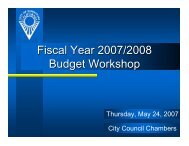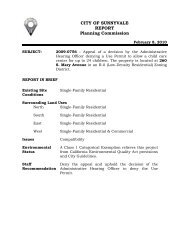City of Sunnyvale Waste Characterization Report
City of Sunnyvale Waste Characterization Report
City of Sunnyvale Waste Characterization Report
Create successful ePaper yourself
Turn your PDF publications into a flip-book with our unique Google optimized e-Paper software.
<strong>City</strong> <strong>of</strong> <strong>Sunnyvale</strong> <strong>Waste</strong> <strong>Characterization</strong> <strong>Report</strong><br />
8. At the end <strong>of</strong> each sampling day, the sampling crew manager will collect the SAMPLE<br />
placards with recorded transaction numbers and net weights from the scalehouse staff.<br />
Summary <strong>of</strong> Expected Roles for Facility Staff in Selecting C&D Loads:<br />
The sampling crew manager will communicate to the scalehouse attendant when the<br />
sampling crew is ready to receive the first load <strong>of</strong> C&D waste during a given dayThe types <strong>of</strong><br />
loads that will be called for include:<br />
— Commercially hauled C&D<br />
— Self-hauled C&D<br />
When the next load arrives that matches the type needed by the sampling crew, the<br />
scalehouse attendant will stop the vehicle and query the driver to ensure that the waste fits<br />
into one <strong>of</strong> the two C&D categories. If the load meets the selection criteria, then the<br />
scalehouse attendant will write the vehicle's license number (or the transaction number) on<br />
the SAMPLE placard and will place the placard on the vehicle's windshield and instruct driver<br />
to go to the sorting area.<br />
When the selected vehicle returns to the scalehouse after having tipped its load, the<br />
scalehouse attendant will retrieve the SAMPLE placard and will write the net weight on the<br />
placard.<br />
The sampling crew manager will collect the completed placards from the scalehouse<br />
attendant at the end <strong>of</strong> each day.<br />
<br />
Sampling and <strong>Characterization</strong> <strong>of</strong> Hand-sorted <strong>Waste</strong> Samples<br />
When a load from a scheduled single-family, multifamily, or commercial route arrives at the<br />
sampling area, the sampling crew manager will confirm information about the load, as discussed<br />
in the previous section, and the driver will be directed to tip the load in an elongated pile below<br />
the operating face <strong>of</strong> the landfill. At this point, the pile will be divided into an imaginary 16-cell<br />
grid, as shown in the diagram below, and a sample <strong>of</strong> waste consisting <strong>of</strong> 200 or more pounds <strong>of</strong><br />
material will be extracted from a randomly selected cell using a loader or other machinery<br />
operated by facility staff. Residual loads sampled from the SMaRT Station MRF will consist <strong>of</strong><br />
samples weighing 125 pounds or more. This material will be placed on a tarp. After the<br />
extracted material is deposited on the tarp, the sampling crew manager will estimate the weight<br />
<strong>of</strong> each sample. If judged to be less than 200 pounds, additional material will be pulled from the<br />
same cell area until the desired weight is achieved. Samples judged to be excessively heavy will<br />
be pared down by removing a homogenous slice <strong>of</strong> material from the tarp. After the sample has<br />
been obtained, the remainder <strong>of</strong> the load can be removed from the tipping area.<br />
_ 68 November 2010


